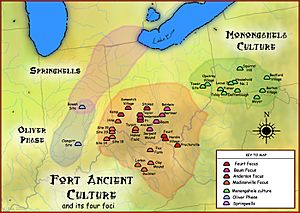Bowen site facts for kids
The Bowen site is a very old village site in Indiana, near the White River in Marion County. It was once home to people who lived there a long, long time ago, around 1000 AD. This site helps us learn about how people lived during the late Woodland period, a time before Europeans came to America.
Contents
The Bowen Site: A Look into the Past
The Bowen site was found by accident in 1959 by people digging for gravel. When they found old artifacts, archaeologists from Indiana University came to study the area. They worked there until 1965, carefully digging up and studying what was left behind.
This ancient village was set up around the year 1000 AD. The people who lived there were influenced by the Mississippian culture, which was a big and important culture in North America. The village was about .78 acres (0.32 ha) in size. It also had a special burial area, about 200 feet (61 m) across, where people were laid to rest.
What Was Found at the Site?
When archaeologists dug at the Bowen site, they found many interesting things. They discovered pieces of broken pottery, sharp stone tools, and bones that had been shaped or used. They also found simple tools like hammers and axes, as well as grinding stones. Even parts of antlers and weapons made from animal bones were uncovered.
These discoveries tell us a lot about daily life. It seems the village was used only at certain times of the year. The people might have moved to other places during the colder months. Then, they would return to the Bowen site when the weather got warmer.
Life in the Village
By looking at the size of the village and the burial grounds, archaeologists can guess how many people lived there. They think that between the years 1000 and 1300, about one hundred people lived in the village on average.
Some of the graves were studied carefully. One person found was about seventy years old when they died. Interestingly, no young men were buried at the site. This might mean they died somewhere else, perhaps during conflicts with other groups. The remains of some young women who died during childbirth were also found. Most of the graves, however, were left untouched.
Unique Pottery and the Oliver Phase
The pottery found at the Bowen site was quite special. It was different from other pottery from the Mississippian era. The pots had a round shape, like those made by the Mississippian people. But they were decorated with shells and other designs, similar to pottery from the Woodland culture around the Great Lakes.
Archaeologists believe this pottery shows a mix of styles. It combines ideas from both the Great Lakes Woodland culture and the Mississippian culture. This unique style of pottery and the culture it represents was named the "Oliver Phase". This name came from a nearby farm. After the first discoveries in the 1960s, archaeologists found more similar sites along the White River in the 1980s and 1990s. These new findings helped them learn even more about the Oliver Phase people.


